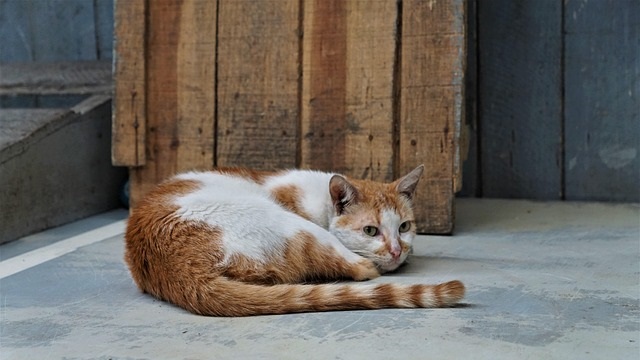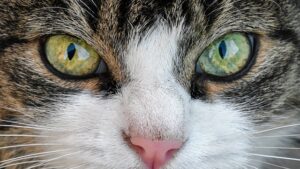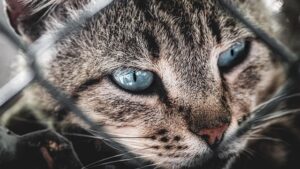How Can I Tell How Old My Cat Is? Simple Age Clues (Vet Verified)
Bringing a new cat into your life is exciting, but for many who adopt or rescue, one central question remains: “How can I tell how old my cat is?”
Knowing your cat’s age is relevant, as it dictates specific vet care, nutrition needs, and at-home care. However, estimating the age of a rescue cat or stray cat can feel like a guessing game.
Fortunately, your feline friend holds several simple, physical clues that can help you estimate their age.
Today, we’ll walk you through the key indicators, offer tips for identifying the age of rescued cats, and explain how to tell if an old cat is comfortable.
Key Takeaways:
- Knowing your cat’s age is important as it dictates specific care and nutrition needs.
- Indicators like teeth, eyes, coat, and muscles are essential to determine your cat’s age.
- You can detect your cat’s aging process by paying attention to physical and behavioral details.
- A cat health tracker allows you to identify subtle behavior changes and get a good estimation of your cat’s age.
How Can I Tell How Old My Cat Is?
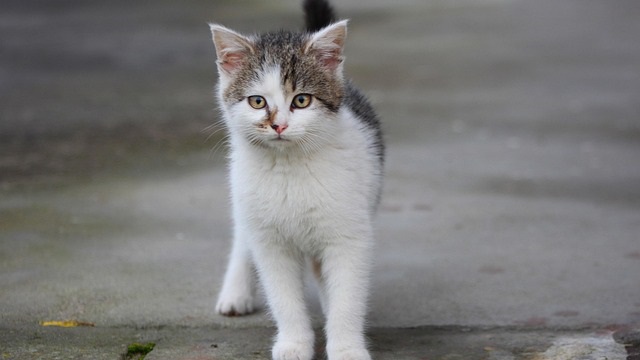
Vets use a combination of physical and behavioral signs to create an age estimate. It’s an estimation, but it’s extremely accurate when multiple factors are considered.
Check the Teeth
The cat’s dentition is the single most reliable physical indicator of age.
- Kitten (Under 6 Months): Has small, sharp “milk teeth.”
- Young Adult (6 Months to 2 Years): Teeth are bright white and very clean, with little to no tartar.
- Adult (3 to 5 Years): Slight yellowing or minor tartar buildup may appear on the back teeth.
- Senior (6 to 10+ Years): Significant tartar buildup, yellowing, and potential gum disease. Some teeth may be chipped, worn down, or even missing.
Pay Attention to the Eyes and Vision
- Young Cat (Under 10 Years): The eyes are typically clear, bright, and alert.
- Senior Cat (10+ Years): The lenses may develop a slight, hazy cloudiness known as lenticular sclerosis. This is a normal part of aging and typically doesn’t drastically impair vision, but dense cloudiness could indicate cataracts, which needs a vet’s attention.
Look at the Coat, Skin, and Muscle Tone
- Coat: Young cats have soft, fine coats. Senior cats may have coarser, thinner, or drier coats. Also, graying hairs may appear around the muzzle.
- Muscle Tone: Young cats have a lean, athletic build. Very old cats often experience muscle loss, resulting in reduced mass over the hips and along the spine.
How Can I Tell How Old My Rescue Cat Is?
The process for a rescue cat is the same as above: focus on the condition of the teeth and eyes. Since you’re building a relationship, also observe their energy levels:
- Activity and Play: High-energy cats (running, climbing, and intense, long play sessions) are often under 5 years old. Cats that play for shorter bursts, preferring long naps, are more likely to be 7 or older.
“Every time Umi is hospitalized, it’s for like four days and it costs over $5,000… Maven has helped me not only save money but also save his life”
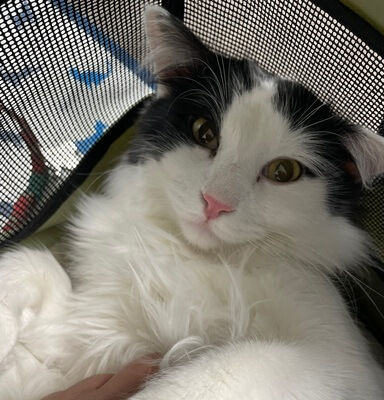
★★★★★
Jessica Ortiz
Umi
How Can I Tell How Old My Stray Cat Is?
Estimating the age of a stray cat uses the same physical clues, but environmental factors often skew the results:
- Accelerated Teeth Wear: A stray cat’s teeth may be more worn or have heavier tartar than a house cat of the same age due to a poor diet or trauma, potentially making them look older than they are.
- Coat Condition: A stray’s coat is often matted, dirty, or dull due to parasites and lack of nutrition. When it comes to stray cats, don’t assume a dull coat means the cat is old.
Common Signs of Aging in Cats
Understanding the typical aging process helps you recognize when your cat becomes a senior.
Physical Signs:
- Hesitation before jumping onto high surfaces
- Difficulty using the litter box
- Stiffness after rest
- Weight loss (sign of a potential health issue)
- Weight gain (consequence of reduced activity)
Behavioral Signs:
- Less interest in playing, hunting, or running
- Increased or persistent meowing, especially at night
- The coat may look unkempt because the cat is uncomfortable bending to clean
How Can I Tell If My Old Cat Is Suffering?
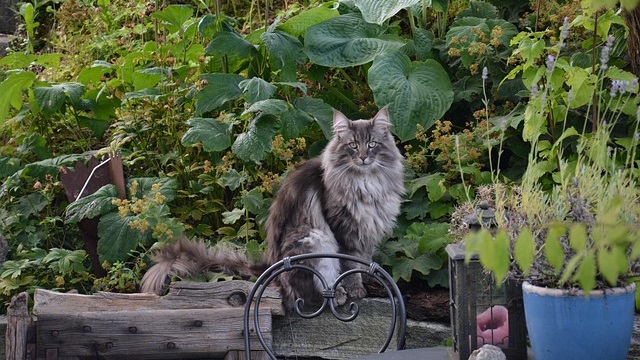
Cats are experts at hiding pain. Recognizing suffering requires noticing subtle behavior changes, such as:
- Hiding: Spending excessive time hidden or isolating themselves, away from family members
- Changes in Posture: A hunched back, lowered head, or reluctance to lie on one side
- Altered Appetite/Thirst: Suddenly eating much less or drinking significantly more or less water
- Aggression: Hissing or swatting when being touched or petted
- Urinating or defecating outside the litter box: strong indicator of discomfort
“Even without exact records, a vet can estimate your cat’s age by examining teeth, eyes, and overall condition. Paying attention to behavior and comfort levels helps ensure they age happily and healthily. The goal isn’t just an age number, but an understanding of their quality of life.” Carolina Domingues, DVM, Veterinarian at Maven Pet
How the Maven Pet Health Monitor Helps Track Aging and Behavior Changes
With a pet health tracker, you can track the subtle, daily changes that indicate aging or discomfort.
This is where a tool like the Maven Pet Monitor becomes invaluable.
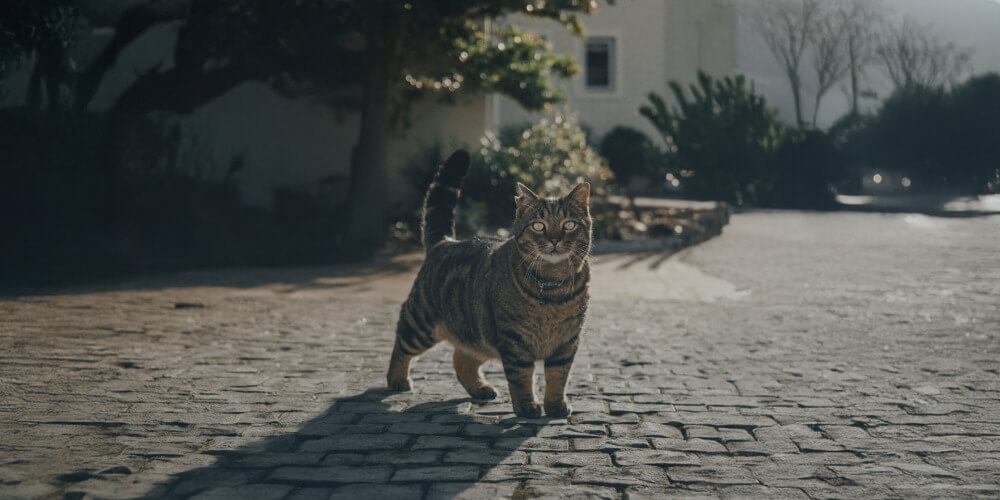
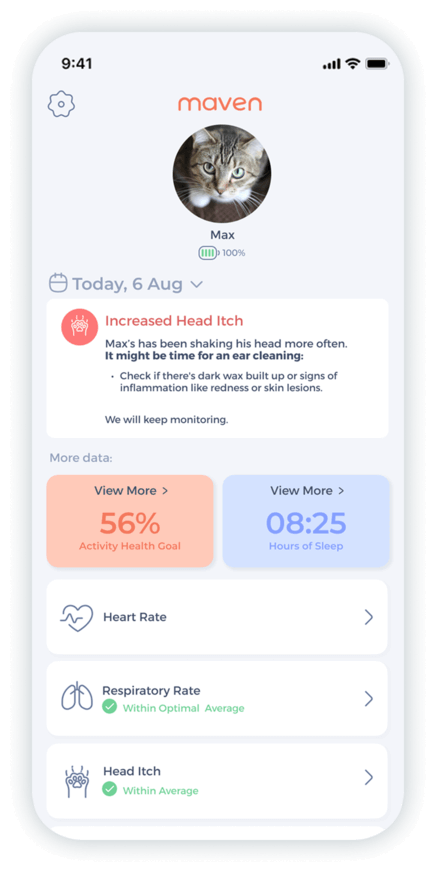
Monitor heart rate, respiratory rate, activity & rest, itch behavior.
The monitor tracks crucial behavioral data 24/7, providing objective insights into:
- Rest Quality and Duration: A sudden increase in sleep or restless nights may indicate pain or stress.
- Activity Levels: A gradual decline in running and jumping is normal, but a sudden drop can signal illness or joint pain.
- Behavioral Patterns: The monitor helps you objectively see if your senior cat is spending more time hiding or vocalizing.
By tracking these metrics, the Maven pet health app establishes a baseline for your cat’s normal life. When a deviation occurs, you can spot the change sooner, discuss it with your vet using hard data, and provide earlier intervention to manage comfort.
Takeaways Recap
- Begin by closely inspecting your cat’s teeth, eyes, and coat condition to get an initial age estimate, especially for a rescue cat or stray cat.
- Use your cat’s energy and activity levels (how much they play or nap) as a general guide to their developmental stage.
- The most important measure isn’t an exact age, but consistently monitoring their comfort, routine, and overall well-being, particularly as they become a senior.
- Use tools like the Maven Pet Health Monitor to track subtle changes in activity, rest, and vocalization, allowing for earlier intervention if pain or decline is present.
Maven Pet focuses on improving the quality of life of our pets with technology, using artificial intelligence (AI) to enable proactive pet care. By accurately collecting and monitoring pet data 24/7 and flagging any irregularities, Maven Pet empowers pet parents and veterinarians to stay ahead of potential health issues, ensuring the well-being and longevity of our beloved companions.

